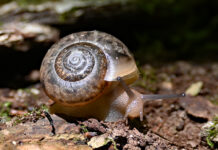
Even in the chilly months of winter, many people have turned to outdoor activities like hiking during the pandemic. Our recent hike in western Beaver County took us to a different time and a different season. It turns out, pursuing health in nature is not a new idea.
We traveled to Raccoon Creek State Park in Beaver County, Pennsylvania. At 7,572 acres, it is one of the largest state parks in Pennsylvania. Built by the Civil Conservation Corps and aided by local men as a part of the Works Progress Administration, the park was transferred from the National Park Service to the Commonwealth of Pennsylvania in 1945.
A rich and colorful history dates even farther back beyond the CCC building years, as we discovered on our hike on the Mineral Springs Loop Trail right off of PA 18 by the park office. The loop trail follows along near the road for a short time before it veers into the woods.
Icy beauty
A beautiful icicle display greeted us, giving us a choice between looking up and looking down at our footing. Knowing my own lack of gracefulness, I decided to stop, look, hike and then stop again. The icicles clung to the shale ledges lining the walls of the ravine.
A two-tier waterfall and grotto were directly in front of us. We had to slow down on the bridge in front of the waterfall. We wanted to look longer, but we also discovered our dog doesn’t like walking across a grated surface. Suspended above the creek on a small wooden bridge and trying to coerce a trembling dog, I took a panoramic view of the waterfall and cave area. The natural beauty was striking.
Once off the bridge, I was able to look beyond the waterfall. I noticed in another area the water seemed to be pouring out of sandstone rocks. Plunging water out of the spring carved a bowl-shaped curve in the rock below it.
Water from the creek was gentle and meandering by nature without much volume in the winter months. The spring water was bursting forth, its origin an underground reservoir. The water pouring out of a rock was the reason many people first came to Beaver County at the turn of the century.
Resort destination

In the 1800s, the mineral springs became the epicenter of a popular resort destination. Frankfort House Hotel and Resort, built by landowner Edward McGinnis, was visited by wealthy families and individuals who desired respite from the city.
McGinnis, after spending many years on rivers as a keel boatman, designed the main house to resemble a steamboat. It was three stories tall with tiered porches running the entire length.
The resort had other buildings and recreational spots, but the mineral springs were the focal point. The springs were marketed to cure many common ailments, including indigestion and arthritis. The popular resort triggered exponential growth in local businesses.
Another hotel was built to accommodate even more people who wanted to visit the mineral springs. The new three-story hotel owned by James Dungan grew in popularity to house an additional 200 guests on summer weekends.
The village also had a post office, churches and a stagecoach stop. A livery service opened up access to the Burgettstown Railroad Station.
It is quite a sight to imagine the elite and wealthy of surrounding cities like Pittsburgh, Steubenville and Sewickley coming to the countryside in their buggies. Their ultimate destination was the mineral springs, but they also enjoyed exquisite dining and dancing by candlelight in the ballroom. From the early morning clip-clop of horses bringing guests to the evening serenade of bowstrings on violins, it was a different world two centuries ago.
The invention of the automobile began the slow decline of the hotel resort. Easier travel made new destinations the first choice of the wealthy. The ownership changed hands multiple times before a fire in the 1920s finally ended the Frankfort resort era.
As we hiked up out of the ravine, we noticed the foundation blocks of a previous building. The frills and fancy clothes of the past have faded into history but the allure of natural beauty still exists in Raccoon Creek State Park. The buildings and businesses have crumbled but the mineral-rich water still bursts out from deep within the earth.
With cold hands and toes, we hiked a little shorter than we anticipated. However, we are sure to head back to the park for more winter adventures, just with more layers of clothing and extra hot chocolate.












